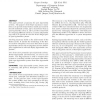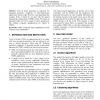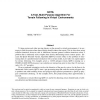HT
1996
ACM
14 years 3 months ago
1996
ACM
This paper presents a taxonomy for open hypermedia systems. The purpose of the Flag1 taxonomy is manifold: 1 to provide a framework to classify and concisely describe individual s...
VRML
1997
ACM
14 years 3 months ago
1997
ACM
Level of detail generation is important for managing geometric complexity of three-dimensional objects and virtual worlds. However, most algorithms that compute levels of detail do...
VRML
1997
ACM
14 years 3 months ago
1997
ACM
This paper describes the use of the Virtual Reality Modeling Language (VRML) in the VIM - Visual Interface to Manufacturing system. The VIM prototype demonstrates the technical fe...
VRML
1997
ACM
14 years 3 months ago
1997
ACM
This paper describes the design and implementation of the user interface for a prototype immersive VRML2 browser, with particular reference to the planning and viewpoint movement ...
VRML
1997
ACM
14 years 3 months ago
1997
ACM
Collision detection is essential for many applications involving simulation, behavior and animation. However, it has been regarded as a computationallydemanding task and is often ...
VRML
1997
ACM
14 years 3 months ago
1997
ACM
To keep avatars and other moving objects on the ground in virtual environments, it is necessary to find the points where these objects should contact the terrain. This is often do...
HT
1997
ACM
14 years 3 months ago
1997
ACM
Hypermedia concepts are currently being deployed in a variety of information systems such as the World Wide Web, software development environments, large engineering enterprises, ...
HT
1997
ACM
14 years 3 months ago
1997
ACM
This paper provides an architectural framework for modeling third-party application integrations with open hypermedia systems, which collects and extends the integration experienc...
HT
1997
ACM
14 years 3 months ago
1997
ACM
The hypermedia field has long realized the need for firstructural abstractions. However, we have failed to generalize the concept of ubiquitous structure management to problem dom...



